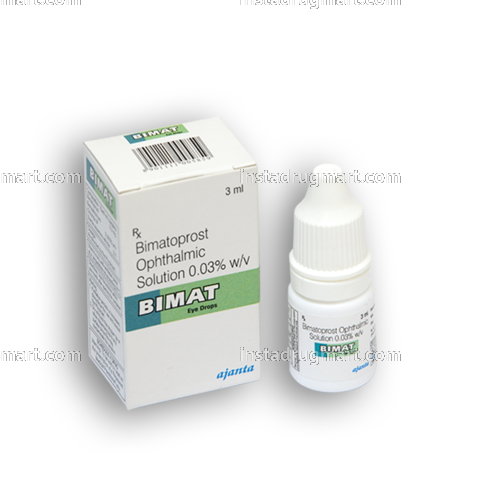Bimatoprost
Bimatoprost 0.03% ml
| Package | Price | Per pill | Save | Order |
|---|---|---|---|---|
|
9 bottles - 0.03% ml |
$251.15 | $27.91 | $30.82 | Buy now! |
|
8 bottles - 0.03% ml |
$223.65 | $27.96 | $26.99 | Buy now! |
|
7 bottles - 0.03% ml |
$196.15 | $28.02 | $23.16 | Buy now! |
|
6 bottles - 0.03% ml |
$168.55 | $28.09 | $19.43 | Buy now! |
|
5 bottles - 0.03% ml |
$140.99 | $28.20 | $15.66 | Buy now! |
|
4 bottles - 0.03% ml |
$113.39 | $28.35 | $11.93 | Buy now! |
|
3 bottles - 0.03% ml |
$85.73 | $28.58 | $8.26 | Buy now! |
|
2 bottles - 0.03% ml |
$57.51 | $28.76 | $5.15 | Buy now! |
|
1 bottles - 0.03% ml |
$31.33 | $31.33 | No | Buy now! |
Drug Title
Bimat (Bimatoprost 0.03%)
Common use
The active ingredient in Bimat eye drops is Bimatoprost.
Your eye contains a watery liquid which serves to feed the interior of the eye. Constantly, this liquid is drained out of the eye, with a fresh made one replacing it. If the draining process is not quick enough, this leads to the rise of the intra ocular pressure. Bimatoprost works by reducing fluid levels and raising the quantity of fluid that is drained from the eye, resulting in a drop of the intra ocular pressure.
Dosage and direction
Bimat eye drops should be applied once, daily, to the eye. You do not have to apply it to both eyes, only to the eye that needs treatment for a diagnosed case of glaucoma or high intra ocular pressure. The preferred time for applying the drug is in the evening.
If Bimat eye drops are used with another type of eye medicine, the time you should wait between the two is fifteen minutes.
To correct way to apply the Bimat eye drops is by first removing your contact lenses, then squeezing a few drops into your eye. After you have done this, you need to proceed to spreading the liquid all over the eye by slowly closing and reopening it.
Contraindications
If you are allergic to the active substance in Bimat eye drops, do not use this drug. Possible symptoms of an allergic reaction are: difficulty breathing, difficulty swallowing, swelling, chest tightness, skin rashes.
Always follow the instructions your doctor or pharmacist gives you for best results.
Do not miss a dose.
Tell your doctor if you are suffering from other illnesses such as kidney or heart disease or if you are pregnant or trying to get pregnant.
Drug interaction
Do not use Bimat eye drops if you are already using one or more of the following drugs: latanoprost ophtalmic, bimatoprost topical, or if you are using other drugs that contain the Latisse or Xalatan active ingredients. Also, if you are suffering from uveitis, renal or liver disease, macular edema, do not use this drug.
Missed dose
It is preferred that you keep the schedule prescribed by your physician, but in the event that you miss a dose, continue using it as you normally do, do not double the dose.
Overdose
Symptoms of overdose may include sensitivity to light and pink eyes. If this is the case, seek immediate medical attention.
Storage
Keep away from heat. Store it in a dark place avoiding heat and moisture. Keep away from children.
Precautions
It is strongly recommended that you talk to your doctor or pharmacist before starting to take this drug.
Tell your doctor about all types of medications that you are using. If you are using other eye medications, ensure that you leave a gap of fifteen minutes between administrating the two.
Do not touch the dropper of the bottle directly with your hands, as you may contaminate it which can lead to infection. Contact lenses make the drug administration difficult, and may interfere with its effects, as they may absorb the drug. If you have had a recent eye injury, contact your doctor before using the drug.
Do not operate heavy machinery after using Bimat eye drops as they may cause temporary impaired vision.
Possible side effect
Some of the most common side effects of this drug are mostly harmless and can include: irritation in the eyes, burning sensation, redness, stinging, itching, watery eyes and sometimes discolouration of the iris.
Other side effects, which are more serious, include headaches, photosensitivity, photophobia, dry eyes, blurred vision, swollen eyelids.

























